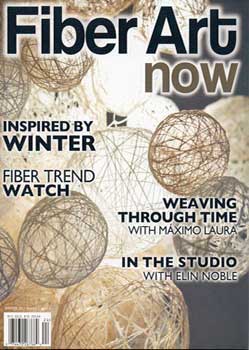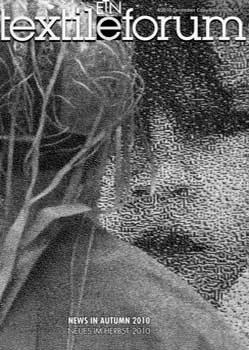Maximo Laura: Visiting with a Visual Poet
Escaping from the monochromatic concrete landscape of a Lima suburb into the private studios of Máximo Laura is like stepping through an exotic portal. Welcomed by Máximo’s dazzling smile into a virtual kaleidoscope of color and texture, alive with glowing animals and ancient images, one immediately senses the presence of a visionary artist.
Máximo Laura is an internationally recognized tapestry weaver whose works have been featured in more than 150 exhibitions in 40 countries. In his native Peru, he was named a “National Living Human Treasure” in 2010. The son of Andean weaver Don Miguel Laura, Máximo has weaving in his blood. As a young boy growing up in Ayacucho, Peru, Laura began by assisting with the preparation of materials, dyeing with natural dyes, and finally weaving cushions, runners, and tapestries in traditional Peruvian style.
Upon entering his private realm, one is immediately struck by Laura’s brilliant use of color. Each vibrant piece leaves the viewer’s senses dazzled and imagination ignited. Having the privilege to visit with Máximo twice, I reached out to learn more about his personal relationship with color and his creative journey as an Andean weaver.
Your weavings are very distinctive, and your use of color is singular. Where do you think your sense of color comes from and what inspires you?
Since I can remember, I have been an obsessive maniac about the search for color through the physical, virtual, artistic, and natural worlds. A flower, butterfly, or fire might especially astonish me. Natural phenomena such as dawn, dusk, flowering, flight, journeys, etc., are ephemeral and all are a part of my repertoire. I delight in living life surrounded by colors.
Growing up in a weaving village in Peru, did you have any “formal” art training with respect to color or design?
I began as an intuitive, self-taught artist, as there were very few classes available. Later I became a disciplined researcher and experimenter. I am a fanatical collector of books, especially ones about color technique and theory. My main academic resources have been books about artists and painters of any style who emphasize color.
With a traditional Andean weaving background, how did you find your own “artistic voice”?
It has been a process for me, researching traditional Peruvian tapestry as well as contemporary international textile art, to create something personal in color designs and technique. I admire various textile artists but consider my primary teacher to be Italian textile artist Helvecia Kela Cremaschi. She taught me how to break away from the basic structures of weaving to experiment and create my own style. I have offered courses, demonstrations, and conferences to promote other weavers and interns in the art. All this has been a great honor for me.
What do you strive to convey with your choice of colors?
Color allows me to freely reinterpret and emulate, redesign and assign the feelings I wish to give to each weaving. In every work, I try to achieve a profusion of variety, contrast, shine, harmony, and the visually poetic. My intention with color is to create a realism that is magical and lyrical by emphasizing the symbolic and ritualistic dimension of my inner vision. I try to make color touch on the sacred as well as the secular. Color enables discoveries of visual impact and excitement for the characters and icons that are recognizable to human experience.
Do you have a particular favorite color or color scheme?
Each individual color is beautiful, though I have a partiality toward combinations of color. I like colors that are vibrant, intense, and energetic: qualities I find in warm yellows, oranges, and reds. My favorite shades range from yellow to red to ochre and blue to violet. I feel that these lend a richness and moving, strong optics. In my weavings, I emphasize colors that are warm and cozy, mysterious and abundant—colors that can stand out.
Each of your weavings seems to have a fantastic blending and shading of each color family. How do you achieve that?
Choosing the colors is the aesthetic “birth” of a work beginning with appropriately balancing the selection of colors, evaluating the hues for correct intensity in a group of color, and finally unifying it all by color temperature. The mixture of thread is then selected for the degradations, distortions, dramatizations that are used to soften, blur, transition, connect, excite, or even to create discord. I strive to achieve the illusion of new colors through the mixing of the colors. I work with more than two hundred colors, which I can mix virtually without limit.
Your colors are so fabulously rich and striking. Does the type of fiber you use affect the coloration?
I mainly use alpaca because it is naturally soft, shiny, and warm, but I also use other natural fibers—animal and vegetable—as well as mixtures of these with synthetic fibers. Each fiber reflects light differently, enriching the varieties of color.
I am struck by the intensely spiritual nature of your weaving. Where does this come from and what is its importance to you?
I have a personal preoccupation with my spirituality and my soul. I think it comes from my encounters since childhood with beliefs, rituals, and holidays tied to the spirituality of life. As a child, I was influenced by my parents, who were deeply rooted in Catholicism, as well as my religious village and its patron saint festivals. As a youth, I encountered the millennial Andean worldview. Its profound spirituality and validity for contemporary times moved me. I feel that the richness of humanity lies in its energy, faith, and its essence of the transcendent. In my Work, I try to demonstrate this in a deliberate, gestural, and suggestive manner through the use of color and symbols that are related most directly to spiritual content.
What advice can you offer to other fiber artists?
Understand that coloration is a magical encounter discovered through process. For me, a piece is only finished when I feel that there is nothing lacking and nothing extra.
Learn more about Maximo Laura
Wild Fibers Magazine
In a culture with a spectacular, centuries-old tradition of textile production, the tapestries of Maestro Máximo Laura stand out from the rest. Máximo Laura’s …
Fiber Art Now Magazine
In many villages throughout Peru, time has stopped. Indigenous people proudly wear traditional clothing that identifies their specific region and community …
Textile Forum Magazine
The following text summarises the content of two conversations I had with Maximo Laura in Costa Rica between 10th and 13th September of this year …
Shop
Explore out catalog of Maximo Laura tapestries available for purchase. All tapestries in this catalog are …









